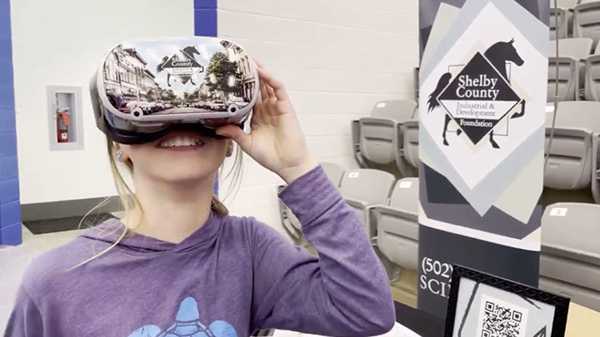By immersing users in an experience, VR provides an introduction to industrial opportunities, expanding businesses and new ways of working.
By Bethany Quinn, President, Golden Shovel Agency
Workforce attraction and retention is a pressing need for U.S. companies and a core program of work for the economic development organizations supporting them. This focus on workforce is especially poignant in light of shifting demographics, labor shortages, and the risk of reduced productivity that makes it difficult for industrial employers to grow. This trend doesn’t show any signs of slowing, either. By one estimate, there will be 1.9 million unfilled jobs in the United States by 2033.
As a result of these seismic shifts, companies have had to identify and implement innovative solutions and leverage modern tools to expand, improve and otherwise enhance their workforce. In their pursuit of this goal, economic development organizations are increasingly finding value in virtual reality (VR) as a resource for creating high-impact introductions to local employers, particularly at the high school level.

VR use has grown rapidly as a recreational and professional tool in large part because of the technology’s power to immerse users in an environment or activity. In recreation-focused uses, that might mean allowing users to soar through the mountains on a paraglider or score a goal in a virtual soccer stadium. For economic development professionals, meanwhile, VR tools offer a uniquely engaging way to introduce users to locations and activities they wouldn’t otherwise have access to and might not even be aware of. By inserting users directly into a location or activity, these virtual experiences offer a more thorough understanding than traditional videos of what it would be like to live or work in a specific location or to operate a particular piece of equipment.
In Kentucky, for example, the Shelby County Industrial & Development Foundation (SCIDF) introduced VR tours as a way to combat the brain drain that results from young people migrating away from their rural area. SCIDF used a series of 360-degree VR videos to provide tours of leading local businesses and allow students to virtually interact with the equipment they would use on the job. Through those tours, many students experienced industrial opportunities that they were completely unaware of.
“I thought it would be a great format to help in career exploration for students in our local high schools and adult job seekers,” said Libby Adams, SCIDF’s Executive Director. “The results have been incredible. People line up to try on the goggles during job fairs. Students are immediately immersed, and it leaves a lasting impression.”
In addition to motivating and inspiring students, these VR experiences have helped SCIDF reach parents and young adults who are already in the workforce but looking for a more fulfilling career. By giving these job seekers firsthand views of new opportunities and allowing them to experience jobs in action, VR videos have helped a broad audience shed outdated concepts of what manufacturing jobs involve.
“Our goal was to motivate and inspire people to look at the opportunities around them,” said Adams.
These opportunities are not limited to industrial careers, either. In Oklahoma, the Broken Arrow Economic Development Corporation is using VR to highlight opportunities in the healthcare field. The community has a respected hospital in Ascension St. John’s as well as demand for healthcare professionals including doctors, nurses, lab techs and first responders. Because healthcare privacy laws make it impossible to bring potential employees into patient rooms, Broken Arrow EDC used VR tours to highlight the hospital’s advanced facilities as well as the fire stations and training facilities available to first responders, helping make the case for Broken Arrow as an appealing place to live and work.
VR has value beyond introducing users to potential careers. It can also help a community highlight its best features for potential residents. In York County, NE, for example, VR has become a way to encourage relocation through highly-engaging experiences that highlight the region’s natural beauty, entertainment opportunities and restaurant scene, among other amenities. Using VR video tours, potential residents can explore the area’s high-quality schools, walk through available housing opportunities and have a realistic experience of splashing down a waterslide, watching the high school band march by, or cruising a wilderness trail on an ATV.
“Using virtual reality, we can give people a new way to experience York County,” said Lisa Hurley, York County Development Corporation’s Executive Director. “It is incredible how virtual reality can transport you to a place and make you feel that you are watching a parade on main street, sliding down a waterslide, sitting in a classroom, racing down a track or touring a factory. By creating this convenient tool, we are making it possible for talent interested in our area to experience York County before they physically visit.”
VR can be a powerful tool for enhancing the workforce that is already in place as well. By placing users in situations that would be difficult or impossible to safely replicate in real life, VR-based training prepares users to face the challenges awaiting them in their day-to-day work. Oregon Trail Electric Cooperative, for example, has used VR training exercises to educate first responders and others about the proper way to respond to incidents involving downed power lines and power poles. Because of its immersive nature, VR has been shown to reduce distractions and ease learning anxiety, and the cooperative found that a VR demonstration made a more lasting impression on their audience than other forms of safety training.
“When you put on the VR goggles, you become fully engaged with the message, and you can’t be distracted,” said Lea Gettle, Manager of Administration and Strategic Services for the cooperative. “The format appeals to all learning styles, and it will make our message a lot more memorable, which will ultimately save lives.”
VR is not a magic bullet for solving labor shortages. Ultimately, any economic development organization will need a comprehensive, multi-pronged approach to addressing its unique workforce needs. But the power of VR to immerse users in a location, an activity, or an occupation makes it a powerful resource for attracting, engaging and instructing potential residents and employees. As a result, thoughtful use of VR may give economic development professionals traction with an audience that would otherwise be reluctant to engage. And that engagement might ultimately prove the difference between a thriving workforce and ongoing struggles.

About the Author:
Bethany Quinn is President of Golden Shovel Agency, an economic development strategy and communications firm. Golden Shovel helps economic developers and business leaders attract talent to their community using virtual reality and 360-degree campaigns to produce real results. Golden Shovel’s virtual reality team develops experiences designed to enhance workforce attraction, expand safety training, and more. For more information visit goldenshovelagency.com.
Read more from the author:
Using Data to Drive Economic Development Success | Golden Shovel, June 17, 2025
In this episode, I sat down with Beejan Giga, Director | Partner and Caleb Emerson, Senior Results Manager at Carpedia International. We discussed the insights behind their recent Industry Today article, “Thinking Three Moves Ahead” and together we explored how manufacturers can plan more strategically, align with their suppliers, and build the operational discipline needed to support intentional, sustainable growth. It was a conversation packed with practical perspectives on navigating a fast-changing industry landscape.